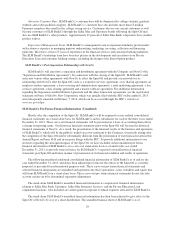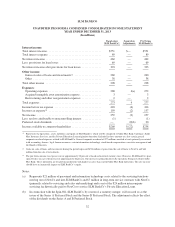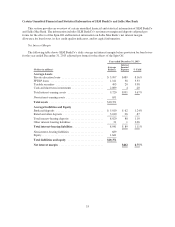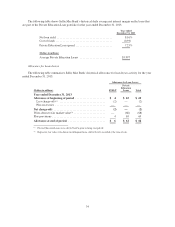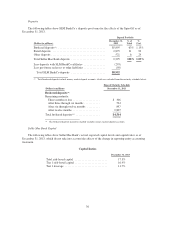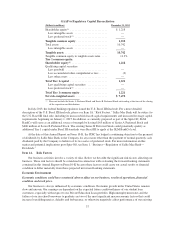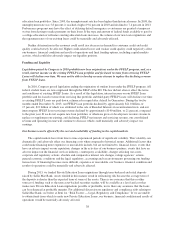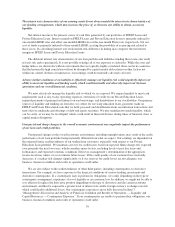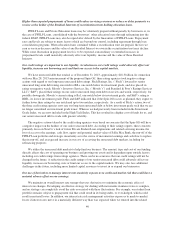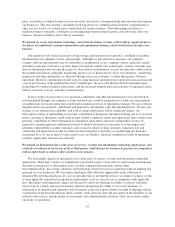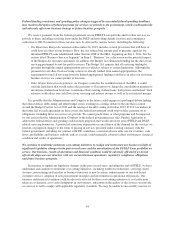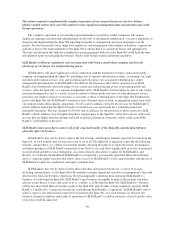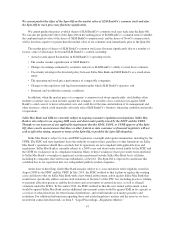Sallie Mae 2013 Annual Report Download - page 40
Download and view the complete annual report
Please find page 40 of the 2013 Sallie Mae annual report below. You can navigate through the pages in the report by either clicking on the pages listed below, or by using the keyword search tool below to find specific information within the annual report.education loan portfolios. Since 2009, the unemployment rate has been higher than historical norms. In 2008, the
unemployment rate was 5.8 percent; it reached a high of 9.6 percent in 2010 and declined to 7.4 percent in 2013.
Forbearance programs may have the effect of delaying default emergence as customers are granted a temporary
waiver from having to make payments on their loans. If the type and amount of federal funds available to pay for
a college education or refinance existing education loans increases, the volume of our new loan originations and
the repayment rates of our existing loans could be materially and adversely effected.
Further deterioration in the economy could result in a decrease in demand for consumer credit and credit
quality could adversely be affected. Higher credit-related losses and weaker credit quality could negatively affect
our business, financial condition and results of operations and limit funding options, including capital markets
activity, which could also adversely impact our liquidity position.
Funding and Liquidity
Legislation passed by Congress in 2010 prohibits new loan originations under the FFELP program, and, as a
result, interest income on the existing FFELP Loan portfolio and fee-based revenue from servicing FFELP
Loans will decline over time. We may not be able to develop revenue streams to replace the declining revenue
from FFELP loans.
In 2010, Congress passed legislation ending the origination of student loans under the FFELP program. All
federal student loans are now originated through the DSLP of the ED. The law did not alter or affect the terms
and conditions of existing FFELP Loans. As a result of this legislation, interest income on our FFELP Loan
portfolio and fee-based revenue from servicing that portfolio and third-party FFELP Loans will decline over time
as existing FFELP Loans are paid down, refinanced or repaid after default by Guarantors. During the twelve
months ended December 31, 2013, our FFELP Loan portfolio declined by approximately $21.0 billion, or
17 percent, $12 billion of which was attributed to the sale of Residual Interests in securitization trusts, and our
intercompany FFELP Loan servicing revenue declined by approximately $140 million, or 21 percent, compared
to the prior year. If we do not acquire new loan portfolios or otherwise grow or develop new revenue streams to
replace or supplement our existing, and declining, FFELP net interest and servicing revenue, our consolidated
revenue and operating income will continue to decrease which could materially and adversely impact our
earnings.
Our business can be affected by the cost and availability of funding in the capital markets.
The capital markets have from time to time experienced periods of significant volatility. This volatility can
dramatically and adversely affect our financing costs when compared to historical norms. Additional factors that
could make financing more expensive or unavailable include, but are not limited to, financial losses, events that
have an adverse impact on our reputation, changes in the activities of our business partners, events that have an
adverse impact on the financial services industry, counterparty availability, changes affecting our assets,
corporate and regulatory actions, absolute and comparative interest rate changes, ratings agencies’ actions,
general economic conditions and the legal, regulatory, accounting and tax environments governing our funding
transactions. If financing becomes more difficult, expensive or unavailable, our business, financial condition and
results of operations could be materially and adversely affected.
During 2013, we funded Private Education Loan originations through term-brokered and retail deposits
raised by Sallie Mae Bank. Assets funded in this manner result in refinancing risk because the average term of
the deposits is shorter than the expected term of some of the assets. There is no assurance that this or other
sources of funding, such as the term asset-backed securities market, will be available at a level and cost that
makes new Private Education Loan originations possible or profitable, nor is there any assurance that the loans
can be refinanced at profitable margins. For additional discussion on regulatory and compliance risks relating to
Sallie Mae Bank, see below at Item 1A. “Risk Factors — Legal, Regulatory and Compliance.” If we are unable
to obtain funds from which to make new Private Education Loans, our business, financial condition and results of
operations would be materially adversely affected.
38



